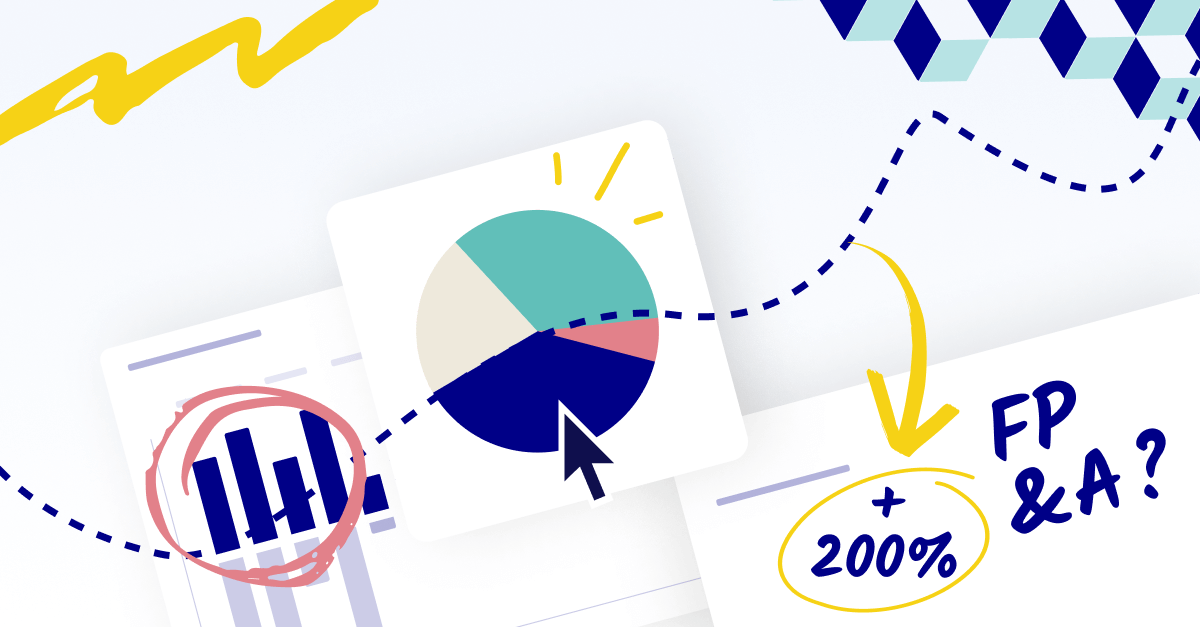Key takeaways on extended planning and analysis
Extended planning and analysis (xP&A) serves several important purposes, such as:
- Bringing together financial and operational data from different departments to provide a clear, unified view of performance.
- Aligning teams like sales, HR, and finance to improve collaboration and develop more effective strategies.
- Enabling quick adjustments to plans by using up-to-date data for smarter, real-time decision-making.
- Growing with your business as data management becomes increasingly complex.
What is xP&A (extended planning and analysis)?
xP&A is an evolution of traditional financial planning models that look at financial data and metrics to make forecasts. It's a rolling model that must be regularly updated to maintain high-quality data integrity.
Think of it as a person's health rather than a company's. Regular FP&A is like watching only the calories (numbers) in and calories out. But xP&A measures and improves muscle mass, bone density, mental health, cardiovascular endurance, and sleep quality. So it's a more holistic approach.
In other words, extended planning and analysis (xP&A) looks at financial and non-financial data to determine a company's financial health and future. That data could include employee retention, operations, and outside market trends. Anything that gives a more complete picture of the entire business.
Here are the three main things that separate xP&A from FP&A:
- Broader scope: xP&A includes data from multiple departments (like sales, HR, and operations), not just finance.
- Faster adjustments: xP&A uses real-time data to let companies quickly react to changes.
- Cross-team planning: The inclusion of multiple departments encourages teams across the company to collaborate better.
How does xP&A differ from other types of financial planning?
Extended planning has a much broader scope than other models. To work to its full potential, it needs three things:
- Collaboration outside the finance department
- Advanced analytics
- Continuous, accurate data
When it works, it’s an impressive model that many in the finance domain call the future.
Now you might be thinking, "Sounds like a headache." And you're not entirely wrong. Especially if you're playing in hard mode. However, the results of properly executed xP&A can be far more potent than traditional financial planning. Adding non-financial data and metrics into the mix unlocks new insights that transform financial decision-making.
Financial planning
Most CFOs and finance teams recognize the budgets, forecasts, and revenue figures needed for financial planning. They know how to generate a snapshot of the company's current performance and potential future performance.
xP&A takes this a few steps further and uses operational data to create a holistic view of the organization. This then determines what big financial decisions should be made in the future.
Here's an example:
A manufacturing company could look at its production schedule, maintenance costs, and warehouse lease. Or a consulting firm might use client feedback, employee turnover rates, and hours billed. Overall, companies then turn those insights into stronger operational plans and, ultimately, better business plans.
If you're thinking, "Yeah, we already do that," then congrats! You're already doing xP&A.
Enterprise planning
Enterprise planning covers long-term goals, strategies, and resource management. It provides a high-level overview of the entire company and defines and executes plans to grow the business.
Extended planning can feed into enterprise planning, also known as business planning, by connecting data from various departments to offer a more comprehensive view of resources and operations. This allows leaders to see how different aspects of the business—like staffing, sales, and operations—affect long-term strategies.
A holistic view of data sets gives a much more complete picture of a company's potential. This can help CEOs and founders set ambitious but sustainable goals.
Why should business leaders choose extended enterprise planning?
Extended planning is a natural choice for founders and CEOs who want to know everything going on in their company where financials could be involved. It pulls information from various departments—like finance, operations, and strategy—to provide a unified perspective for improved decision-making. It can increase collaboration between teams, create an agile business, and foster a culture of transparency.
Each company has a product or service to provide. Extended planning pulls in previously untouched data sources that can give a far more comprehensive view of what customers are looking for, enjoying, and giving feedback on. This gives business leaders a better idea of their customers' needs and wants. Not to mention that it can inform operational areas of their own risks and inefficiencies. These could include workforce planning models, scenario planning, or sales planning.
Essentially, it’s the new financial planning kid on the block.
Benefits of extended planning
So, we’ve piqued your interest. Extended planning’s comprehensive analysis benefits companies struggling with operational bottlenecks affecting revenue. Here are more reasons why this connected planning style might be your business's next best thing.
Dynamic processes
Extended planning allows companies to adjust their strategies continuously rather than relying on rigid, annual plans. This means businesses can pivot quickly if market conditions change, timelines shift, or unexpected issues arise, like supply chain disruptions. Staying agile allows companies to implement changes faster so projects remain on track and relevant to the current market.
Concise collaboration
The centralized data from multiple departments eliminates data silos and leads to better communication. This allows finance, sales, and operations teams to work with the same up-to-date information. Businesses can even reduce miscommunication by making faster and more collaborative decisions. For example, sales teams can instantly inform finance teams about forecast changes so they can make accurate budget adjustments.
Transparency
Nobody wants shadowy organizations that don’t let everyone know what’s happening. The fact that extended planning models are continuously updated means there’s more accountability from everyone.
Investors and key stakeholders, in particular, benefit from this transparency since they gain real-time insights into company operations and financial health for board reporting.
Risk management
Your risk team will certainly be happy to see a more comprehensive view of potential risks. Putting together such a wide range of data from different points across the company allows you to identify vulnerabilities early on—like supply chain issues, workforce shortages, or financial imbalances. Your team can take proactive steps to reduce the likelihood of costly disruptions.
Increased performance
Connecting financial and operational data gives businesses the insights they need to drive better performance and higher revenue over time. Teams can identify bottlenecks in workflows and adjust their plans to relieve them. With a clearer picture of where resources are being wasted or underutilized, companies can fine-tune their operations to allocate their resources more effectively.
Automation opportunities
Today’s financial software platforms use AI and automation to simplify manual tasks like data entry, making forecasts, and creating reporting. With AI, businesses can free up valuable time previously spent on repetitive tasks and focus on how to drive strategic planning. For example, automation can instantly consolidate financial data from multiple departments, rather than having someone in front of a computer for hours typing away at numbers.

Drawbacks of extended planning
While the benefits are great, extended planning has some potential downsides. You should carefully consider these before you implement any big changes.
Cost
Extended planning involves integrating a new system or software into the company, so it can quickly increase in price. Fully integrating the data is also resource-intensive. You may need to hire and train staff to manage the process, so it’s an expense in multiple ways.
Data quality
Even once you’ve perfected the system, you might not get the best results without decent data.
With a model so reliant on metrics, the quality of the inputted data is everything. This could look like incomplete, inaccurate, or out-of-date metrics. Anything not up to scratch will throw off the outputs and impact the company’s decision-making process.
Resistance to change
If you tell anyone in the business that their or their team’s reporting workload is increasing, it won’t be a popular move. Even when it’s for such a good reason, employees won’t appreciate the transition if it’s poorly handled. Your team may want to stick to the way they were originally trained to avoid disrupting their workflow.
How to integrate xP&A with existing FP&A systems
Successfully incorporating extended planning and analysis (xP&A) into your current FP&A systems requires a strategic approach to ensure a seamless transition. The process looks something like this:
1. Conduct a comprehensive assessment
Review your current FP&A infrastructure to identify strengths, weaknesses, and specific requirements. For example, is your current system slow with reporting? Do you lack cross-department data integration? This assessment should be in-depth so you’re aware of any gaps or limitations in your existing system that xP&A can address.
2. Choose the right xP&A platform
Make sure the xP&A platform integrates easily with your current tools (like Excel or ERP systems) so there are no disruptions to your workflows. It’s important to read trusted reviews before committing to the change.
3. Develop a robust data migration strategy
Work with IT and your xP&A vendor to create a step-by-step data migration plan. Your vendor should have a person or team dedicated to making your transition as smooth as possible. Identify which data sets need to be prioritized, run tests to ensure smooth transitions, and schedule migration during low-activity periods to reduce system downtime.
4. Prepare your team for the shift
Offer hands-on training and communicate the benefits of xP&A clearly so your team is fully on board with the change. Set up feedback avenues where employees can report challenges during the transition. It would be wise to communicate that errors may occur, so no one feels defeated or overwhelmed if things don’t work as intended right off the bat.
By following these best practices, you can navigate the integration process effectively, enhancing your FP&A capabilities and facilitating more informed decision-making.

The xP&A planning processes
There are a few different methods that xP&A uses to be such a brilliant prediction model. Below, we’ve outlined some of the most common techniques you could harness to make the most of your data.
Data integration
We’ll start with the obvious one: integrating the company's relevant financial and operational data from different departments.It sounds simple, but it can be tricky to see where to start.
The answer: let your business’s KPIs dictate the data streams, then work from there. You can always add or subtract metrics as needed.
Visualization tools
Humans are visual creatures by nature. Putting data in an easy-to-digest format like graphs and charts works well for something as complex as extended planning.
Using the software, you can create dashboards to show KPIs against goals, other relevant data points, and any risks. These can be fully customized to your company’s needs.
Other standard visualizations for extended planning include maps to show geographic data, like sales by region, or heat maps to quickly identify trends.
Collaborative planning
To get the most out of extended operational planning, you’ll need the help of several key departments across your organization. Each provides key metrics and information to build out the extended planning model.
As a result, you’ll get different perspectives from each department that help to give a wider picture of what’s going on in the company. This makes financial management much more efficient and encourages integrated business planning styles. The upshot is your departments will work better together, there’ll be more buy-in for the new system, and more employees will feel connected to the company’s purpose.
A win-win!
Advanced analytics and artificial intelligence
You can use different forms of AI and advanced analytics in your extended planning to maximize benefits.
Machine learning
Algorithms can identify trends and patterns in data that might otherwise go undetected like areas for optimization, potential risks, and more.
What’s not to love?
Predictive modeling
This technique models potential future outcomes based on the historical data inputted into it. This can then inform of any risks and opportunities going forward.
Text analysis
You could implement text analytics if you have text-based data such as customer insights, survey responses, or product reviews. It uses natural language processing to pull out any glimmers of information that might be useful for modeling.
Continuous improvement model
Extended planning is an ongoing process. Instead of annual updates, it requires more maintenance and integrated planning for a bigger pay-off.
Think of your data that might be regularly coming in: customer feedback, sales figures, or AP and AR to name a few. These all have a big impact on a company's financial and operational activity. Keeping xP&A updated means you’re not missing out on valuable information.
Continually updating the extended planning model means any issues in the company can be spotted quickly, staff can use the system regularly, and continuous experimentation to improve xP&A is possible.
xP&A: top tips to know
If you’re sold on the extended planning model, you might be wondering how best to go about making the switch. It’s not a one-size-fits-all process, so you’ll need to carefully look at your business and how it would work for you. Here are some ideas to get you started on the path to successful xP&A.
1. Work out the KPIs
For extended planning, it’s worth looking over the company’s financial and operational KPIs to steer the direction of the data you’re working with.
Without KPIs, you’re flying blind. Plugging in data sets without a goal or strategy in mind won’t give you the best results. In fact, you’ll likely have too much information to work with. The name of the game is to choose relevant metrics to inform future decisions. KPIs give the extended planning much-needed structure within which to work.
2. Think outside the box
Didn’t think financial budgeting could be creative? Think again. Extended planning allows businesses to dig into issues that might otherwise go unnoticed.
Inputting new sources of information from otherwise overlooked data sets could bring new levels of insight to the company.
This could look like text analysis of social media posts for market trends, weather patterns for hospitality businesses, or location data.
Going against the grain to get deeper insights will only help to inform the financial decisions an organization should make.
3. Establish structure around the process
If you opt for a rolling extended planning model, it’s worth setting up a schedule of key dates.
There’ll be a few different departments to organize, so setting out a calendar of deadlines for reporting to be completed will smooth things out.
xP&A can be complex depending on the size of the business. You might even need to hire someone specifically trained and focused on extended planning, or add it into employee responsibilities.
Key stakeholders and investors may want some oversight or involvement in the process. Setting up policies and regular evaluations to help the planning is always a good idea.
4. Train employees
Trained employees who are confident in their abilities to work with the extended planning model will feel empowered to make their own decisions based on the information. Encouraging ongoing learning around these will help to remedy any data silos in the company. Offer access to professional memberships, webinars, and training courses.
5. Use internal comms to your advantage
If you’re implementing extended planning for the first time, the increased engagement and reporting needed from employees might result in some grumbles. Internal communications teams can share information on your behalf, gather employee feedback, and build support.
You can engage staff in various channels such as emails, video campaigns, and other internal communications channels like Slack and Notion.
Future trends in xP&A for FP&A decision-makers
By embracing these future trends and adopting proactive strategies, FP&A decision-makers can position themselves at the forefront of xP&A innovation, ensuring they are well-equipped to meet the evolving challenges of financial planning and analysis.
AI and ML integration: As technology advances, integrating Artificial Intelligence (AI) and Machine Learning (ML) into xP&A processes is gaining traction. These technologies enhance forecasting accuracy, automate tasks, and extract valuable insights from extensive datasets.
Embracing predictive analytics: Predictive analytics is emerging as a powerful tool within xP&A, enabling organizations to move beyond historical data and make proactive, forward-looking decisions. FP&A professionals should explore predictive analytics models to anticipate market trends, customer behaviors, and potential financial outcomes.
Increased emphasis on data visualization: With the growing complexity of financial data, the emphasis on effective data visualization and interpretability is gaining momentum. Accessible and clear visualizations facilitate better understanding and informed decision-making across the organization.
Cloud-based xP&A solutions: The future of xP&A lies in the cloud. Cloud-based solutions offer scalability, flexibility, and improved collaboration among dispersed teams. Cloud solutions also facilitate real-time data access, promoting faster and more informed decision-making.
Sustainability and environmental, social, and governance (ESG) metrics: Increasing emphasis on sustainability and ESG metrics is shaping xP&A trends, reflecting a growing demand for socially responsible financial practices. FP&A professionals should consider integrating ESG metrics into their analyses, providing a holistic view of financial performance that aligns with broader environmental and social goals.
The bottom line on extended planning and analysis
So is xP&A really the next best thing in finance since, well, Excel?
On the one hand, it's just a fancy term for holistic FP&A. On the other hand, embracing an xP&A mentality is a great first step towards more comprehensive and accurate financial planning, which we can all get behind.
No matter what kind of financial planning you're trying to do, Cube can help. We integrate with Excel and Google Sheets, plus all of your source systems. So it's never been easier to get your HRIS data into your Excel model and share it with the Head of Engineering over a Google Doc.



.png)









.png)

.png)



![The 5 best mid-market planning tools for business [updated for 2024]](https://www.cubesoftware.com/hubfs/Mid-Marketing%20Planning%20Tools%20(1).png)
![12+ Best FP&A software for small businesses [2025]](https://www.cubesoftware.com/hubfs/EBook%20Cover%20(33).png)
